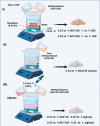Fast, Easy, and Reproducible Fingerprint Methods for Endotoxin Characterization in Nanocellulose and Alginate-Based Hydrogel Scaffolds
- PMID: 39262301
- PMCID: PMC11480981
- DOI: 10.1021/acs.biomac.4c00989
Fast, Easy, and Reproducible Fingerprint Methods for Endotoxin Characterization in Nanocellulose and Alginate-Based Hydrogel Scaffolds
Abstract
Nanocellulose- and alginate-based hydrogels have been suggested as potential wound-healing materials, but their utilization is limited by the Food and Drug Administration (FDA) requirements regarding endotoxin levels. Cytotoxicity and the presence of endotoxin were assessed after gel sterilization using an autoclave and UV treatment. A new fingerprinting method was developed to characterize the compounds detected in cellulose nanocrystal (CNC)- and cellulose-nanofiber (CNF)-based hydrogels using both positive- and negative-ion mode electrospray ionization Fourier transform ion cyclotron resonance mass spectroscopy (ESI FT-ICR MS). These biobased hydrogels were used as scaffolds for the cultivation and growth of human dermal fibroblasts to test their biocompatibility. A resazurin-based assay was preferred over all other biocompatibility methodologies since it allowed for the evaluation of viability over time in the same sample without causing cell lysis. The CNF dispersion of 6 EU mL-1 was slightly above the limits, and it did not affect the cell viability, whereas CNC hydrogels induced a reduction of metabolic activity by the fibroblasts. The chemical structure of the detected endotoxins did not contain phosphates, but it encompassed hydrophobic sulfonate groups, requiring the development of new high-pressure sterilization methods for the use of cellulose hydrogels in medicine.
Conflict of interest statement
The authors declare no competing financial interest.
Figures






References
-
- Ghafari R.; Jonoobi M.; Naijian F.; Taheri A.; Mekonnen T.; Sheshmani S. Fabrication and characterization of bilayer scaffolds - nanocellulosic cryogels - for skin tissue engineering by co-culturing of fibroblasts and keratinocytes. Int. J. Biol. Macromol. 2022, 223 (1), 100–107. 10.1016/j.ijbiomac.2022.10.281. - DOI - PubMed
-
- Orlando I.; Roy I.. Cellulose-Based Hydrogels for Wound Healing. In Cellulose-Based Superabsorbent Hydrogels, 1st ed.; Mondal M., Ed.; Polymers and Polymeric Composites: A Reference Series; Springer: Cham, 2019.
-
- Lieder R.; Gaware V.; Thormodsson F.; Einarsson J.; Gislason J.; Masson M.; Petersen P.; Sigurjonsson O.; Ng C. Endotoxins affect bioactivity of chitosan derivatives in cultures of bone marrow-derived human mesenchymal stem cells. Acta Biomater. 2013, 9 (2), 4771–4778. 10.1016/j.actbio.2012.08.043. - DOI - PubMed
Publication types
MeSH terms
Substances
LinkOut - more resources
Full Text Sources

